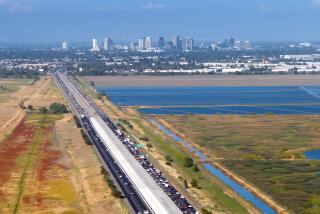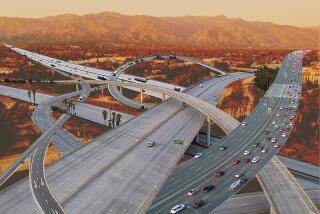Littering Drivers Can Really Burn You Up
- Share via
Reader Lawrence Kim was still smoldering the other day when he wrote to us to complain about freeway litter, especially cigarette butts--which he now knows can create more than just an eyesore. “This is a hot topic for me,” Kim explained, “because while driving through Irvine some troglodyte actually tossed out a lit cigarette that ended up landing on my lap in my car.”
Ouch. Luckily, Kim reacted quickly (and who wouldn’t?) and managed to escape the incident without burns or a car crash. But it inspired him to ask us if there was a hotline for reporting litterbugs like the ones for reporting graffiti and smog-spewing vehicles.
We hate to break this to you, Lawrence, but looks like the answer is no.
“The problem with a hotline would be that, to give a ticket, the police officer obviously has to observe the violation,” according to Steve Kohler, a spokesman in Sacramento for the California Highway Patrol. “Just hearing about it secondhand isn’t enough under the law.”
Too bad. If there was a phone number to report trashy scofflaws, we’d use it all the time. Like a lot of folks, we seethe when other drivers use the roadside as a garbage can. Some smokers are under the impression that their cigarette butts just disintegrate in the elements, but those filters don’t degrade.
“Littering is an expensive thing to do, and if we observe you do it, the ticket is up to a $1,000 fine,” Kohler told us. But Kim thinks there needs to be more.
“I personally believe any person caught littering while in a vehicle should have his license suspended for two weeks,” Kim told us. But later, perhaps reflecting on his encounter with a burning cigarette, he had another thought. “I’d really prefer public whippings.”
COUPLE SEEK DIRECTION: Your humble Roads Scholar hates to interfere in matters of the heart, but these letters just keep coming in. Every week or so we get a question from a couple who have a disagreement they expect us to settle. It’s dangerous taking sides, but, hey, danger is our business. This week, we present the question sent in by reader Jeanie Stapleton: “My boyfriend and I disagree about the legality of making U-turns in certain areas. I say that you can only legally make a U-turn at an intersection, unless you are in a strictly ‘residential’ area. Tony says that it is legal to make a U-turn anywhere that it is OK to make a left turn--even mid-block, whether the area is business or residential. Who is right?”
It would seem an easy question but, as CHP spokesman Kohler puts it, “Nothing is easy when it comes to the California Vehicle Code.” That said, here’s the lowdown on turnarounds:
In a residential area, you can make a U-turn at intersections unless there is a sign telling you they are illegal. You can also do it midblock--but only if there are no approaching cars within 200 feet in either direction.
In a business district, you can, again, make a U-turn at intersections unless a posted sign says otherwise. As for midblock U-turns, that’s a bit more complicated. You can do it legally on a divided highway (defined as a roadway split by a two double yellow lines or a median of two feet or more) if there is a break in the center divider, such as a left-turn pocket. If you have to cross double yellow lines to make your U-turn, you’ve broken the law, says Sgt. Bill Ehart of the Santa Ana police.
“My advice is, in a business district, wait until the next light,” Ehart said, pointing out that there are more times when the midblock maneuver is illegal than legal. “And don’t ever do it in front of a fire station. There’s a law just for that.”
So, Jeanie, the answer is you and your boyfriend are both right. Or you are both wrong. Either way, that’s what love is all about, isn’t it?
WHAT IS THAT?: Several readers, most recently Ron Sadick in Cypress, have asked that very question about the pink brick building that has popped up in the plot of land hemmed in by the Corona del Mar and Costa Mesa freeways and Bristol Street in Costa Mesa. The answer is a Caltrans maintenance yard, which opened earlier this month.
Dan Sizemore, leader of the California Department of Transportation crew in Costa Mesa, said the building’s location amid ramps and overpasses has confused a few drivers, including a few who thought the facility’s driveway was an onramp. “We almost had a head-on collision, but now that we put some signs up out there, it hasn’t been much of a problem,” he told us. The 60 employees to be based at the building include a lot of veteran road workers who weren’t thrilled to see their new headquarters was “a pink palace,” as Sizemore puts it. “Yeah, I think a different color might have been better, but it’s no big deal, really,” he said.
THINKING ABOUT DRINKING: Statistics show summer months are the most dangerous when it comes to alcohol-related crashes, but the good news is that drunk-driving incidents overall have declined in recent years. One key reason is more than a decade of public awareness programs that have stepped up the drumbeat against casual drinking and driving. Some of the campaigns, like the recent, heart-rending television commercials that show home video snippets of youngsters who have died in crashes, play on the emotions. But a new brochure from the Automobile Club of Southern California uses a more cerebral tactic.
“None for the Road: A Guide to California’s DUI Laws” is a comprehensive, 15-page look at the nuts and bolts of drunk driving offenses and consequences. From the jail time you can expect to serve (the range is 48 hours to four years, except for first-time misdemeanor offenders who may walk out of court on probation) to the intricacies of license suspensions, this is the best analysis we’ve seen and it is, excuse the pun, sobering reading indeed.
“California has some of the nation’s strictest laws for those who drive while under the influence of alcohol or drugs,” says Arline Dillman, traffic safety manager for the club. “Unfortunately, as these laws have become tougher, they’ve also become more complex. The Auto Club brochure explains the laws in a clear, easy-to-read format.”
You can get the brochure at any of the 10 Auto Club offices around Orange County or by calling (800) 541-5552. You can also find it at https://www .aaa-calif.com/members/corpinfo/duiguide.html on the Internet.
The Roads Scholar wants to hear your insights, stories and questions about traffic, the commuting experience and Orange County transportation issues. You can call him at (714) 966-5724, send e-mail to geoff.boucher @latimes.com or mail letters to him at The Times Orange County, P.O. Box 2008, Costa Mesa, CA, 92626. Please include your full name, hometown and phone number.
More to Read
Sign up for Essential California
The most important California stories and recommendations in your inbox every morning.
You may occasionally receive promotional content from the Los Angeles Times.










